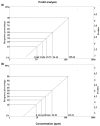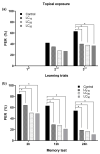Olfactory Learning Behavior and Mortality of the Honey Bee Apis mellifera jemenitica in Response to Pyrethroid Insecticide (Deltamethrin)
- PMID: 38250981
- PMCID: PMC10818679
- DOI: 10.3390/toxics12010025
Olfactory Learning Behavior and Mortality of the Honey Bee Apis mellifera jemenitica in Response to Pyrethroid Insecticide (Deltamethrin)
Abstract
Honey bees are constantly threatened due to the wide use of pesticides. This study presents the effects of deltamethrin on the mortality, olfactory learning, and memory formation of the native Saudi bee Apis mellifera jemenitica. Topical and oral application of realistic field and serial dilutions of deltamethrin (250, 125, 62.5, and 25 ppm) caused significant mortality at 4, 12, 24, and 48 h posttreatment. Bee mortality increased with the increasing concentration of insecticide at all tested posttreatment times. Highest mortality was observed at 24 h and 48 h after both exposure routes. Food consumption gradually decreased with increasing concentration of deltamethrin during oral exposure. The LC50 of deltamethrin was determined at 12, 24, and 48 h for topical (86.28 ppm, 36.16 ppm, and 29.19 ppm, respectively) and oral (35.77 ppm, 32.53 ppm, and 30.78 ppm, respectively) exposure. Oral exposure led to significantly higher bee mortality than topical exposure of deltamethrin at 4 h and 12 h, but both exposure routes were equally toxic to bees at 24 h and 48 h. The sublethal concentrations (LC10, LC20, and LC30) of deltamethrin significantly impaired the learning during conditioning trials, as well as the memory formation of bees at 2, 12, and 24 h after topical and oral exposure. Thus, deltamethrin inhibits learning, and bees were unable to memorize the learned task.
Keywords: Saudi Arabia: toxicity; honey bee; insecticide; learning; lethal concentration; memory.
Conflict of interest statement
The authors declare no conflicts of interest.
Figures









References
-
- Gallai N., Salles J.-M., Settele J., Vaissière B.E. Economic valuation of the vulnerability of world agriculture confronted with pollinator decline. Ecol. Econ. 2009;68:810–821. doi: 10.1016/j.ecolecon.2008.06.014. - DOI
Grants and funding
LinkOut - more resources
Full Text Sources

